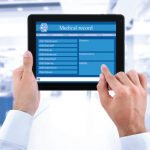Having an electronic heath record (EHR) system in your practice has many benefits, such as Medicare incentives, quality improvement, and increased office efficiencies. Falling in the “office efficiencies” category is the ability to clone notes, which allows you to cut and paste notes from one visit to another. This documentation option for physicians using EHRs puts them at risk for audits.
The Office of Inspector General (OIG) has included in the 2012 Work Plan an assessment of evaluation and management services “to identify electronic health records documentation practices associated with potentially improper payments,” stating, “Medicare contractors have noted an increased frequency of medical records with identical documentation across services.”1
It is easy to fall into the trap of cloned notes while using an EHR because the capability to bring forward notes from previous visits can be a great time saver. However, there is a risk that previous notes are not pertinent to the current visit, or that documentation will start to become uniform.
For example, if a history of present illness note is carried over from a previous visit, but the chief complaint and present illness do not match the review of systems the patient filled out, the note is not pertinent to the current visit, raising a red flag for OIG to investigate.
Cloned notes can lead to unnecessary audits. Medicare carriers and Recovery Auditor Contractors have the authority to pull medical records up to three years old if they suspect any fraud or abuse. Since there has been an increase of identical documentation in medical records, the OIG has intensified their efforts to assess the policies and procedures in place for fraud.
Take some time to perform self-audits or have a consultant audit your practice regularly to ensure that your EHR is coding to the correct level of service. Keep in mind that the EHR is just a tool, and you have ultimate control of the documentation. To protect your practice from falling into the trap of cloned notes, review all the notes that are brought over from a previous visit to ensure that all the information for the current visit is accurate.
Understanding coding and documentation guidelines are your best defense against the bad side of cloned notes. If you need assistance with coding and reimbursement, contact the ACR’s practice management department at (404) 633-3777 or [email protected], or join the ACR coding list serve at www.rheumatology.org/membership and post your questions online.
Example of Cloned Notes

Four weeks ago, a 65-year-old female visited Dr. Brown for a follow-up visit for her rheumatoid arthritis. While there, she also complained of diarrhea and stomach cramps from the new medication that she was prescribed. The rheumatologist made a decision to discontinue the medication and switched the patient to a new drug.
The same patient returned today to see Dr. Brown for a follow-up visit for her rheumatoid arthritis, but there are no more complaints of diarrhea and stomach cramps. The EHR allows Dr. Brown to pull the notes over from the last visit, which he does, but does not edit or remove the symptoms of the diarrhea and stomach cramps.
By not editing the notes, Dr. Brown may create documentation of this visit that does not support medical necessity for the level of visit, resulting in no payment for the charges billed. (For an in-depth review of medical necessity, read “Medical Necessity—What Does it Mean?” on page 16 in the January 2011 issue of The Rheumatologist).
